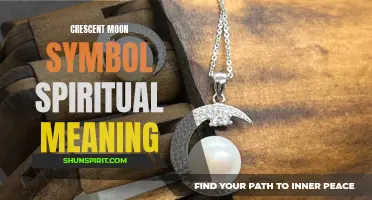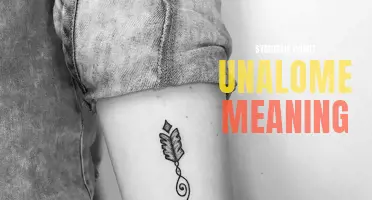
The Taino people, indigenous to the Caribbean islands, had a rich and vibrant culture that was deeply intertwined with nature. One of the most fascinating aspects of their culture was their use of symbols, which held significant meanings and were intricately woven into their daily lives. These symbols served as a way to communicate, honor their ancestors, and connect with the spiritual world. Today, exploring Taino symbol meanings not only offers a glimpse into their ancient civilization but also reveals the timeless wisdom and reverence for nature that still resonates with people today.
What You'll Learn
- What are some common Taino symbols and their meanings?
- How did the Taino people use symbols in their daily lives?
- Are there any Taino symbols that are still in use today?
- What do Taino symbols represent in terms of their spiritual beliefs and practices?
- How have Taino symbols influenced modern Caribbean and Latin American art and culture?

What are some common Taino symbols and their meanings?
The Taino were an indigenous Arawak-speaking people who inhabited the Caribbean islands, including present-day Puerto Rico, Cuba, and Hispaniola (Haiti and the Dominican Republic) before the arrival of Columbus. They had a rich culture and used various symbols to convey their beliefs and ideas. Here are some common Taino symbols and their meanings:
- Coqui: The coqui is a small tree frog native to Puerto Rico. It is a symbol of fertility and good luck. The sound made by the male coqui during mating season is considered a positive sign.
- Sun: The sun symbolizes life and energy. It represents the supreme creator deity in the Taino cosmology, giving light and warmth to sustain all living beings.
- Moon: The moon symbolizes femininity, fertility, and the cycles of nature. It is associated with agricultural activities and the tides.
- Zemi: Zemi sculptures were stone idols and representations of spirits or deities in the Taino religion. They were often carved with multiple heads or extraordinary features. The zemi symbolizes the connection between humans and the spiritual realm.
- Spiral: The spiral symbolizes the infinite cycles of life, death, and rebirth. It represents growth, evolution, and transformation. The Taino believed in the concept of reincarnation and the interconnectedness of all living things.
- Petroglyphs: Petroglyphs are rock engravings found throughout the Caribbean. The Taino used petroglyphs to communicate and record their stories and history. These symbols often depict animals, plants, celestial bodies, and human figures.
- Ceiba Tree: The ceiba tree is a sacred tree in the Taino culture. It is believed to connect the heavens, the earth, and the underworld. It symbolizes strength, stability, and the interconnectedness of all life forms.
- Yuca (Cassava): The yuca plant was a staple crop for the Taino people. It symbolizes sustenance, fertility, and abundance. The Taino believed that their gods and ancestors dwelled within the yuca plant.
- Water: Water symbolizes life, purification, and the flow of energy. It is associated with rivers, rain, and the sea. The Taino believed in the importance of water for their survival and considered it a sacred element.
- Cemi: A cemi is a small stone or shell artifact that was used for various religious and ceremonial purposes. Each cemi represented a particular deity or spirit and was considered a powerful and sacred object.
These symbols played an important role in the Taino culture, serving as a means of communication, expression, and connection with the spiritual realm. Today, these symbols continue to be revered and celebrated by the descendants of the Taino people as a way to honor their rich heritage and keep their traditions alive.
Understanding the Symbols on POF: Unlocking the Meaning Behind the Icons
You may want to see also

How did the Taino people use symbols in their daily lives?
The Taino people, an indigenous group who inhabited the Caribbean islands before the arrival of Christopher Columbus, had a rich cultural tradition that included the use of symbols in their daily lives. Symbols played a crucial role in their religious, artistic, and practical activities, providing a means of communication and expression.
Religious symbols held great significance for the Taino people. They believed in a complex system of deities and spirits, and symbols were used as a way to connect with the spiritual realm. The most important symbol in their religious practices was the coa, a carved wooden object shaped like a zemi (a Taino deity). The coa was used in ceremonies to honor the gods and ensure their favor. It was also believed to possess spiritual power and was used to communicate with the spiritual world.
In addition to religious symbols, the Taino people used symbols in their artwork. They were skilled artisans, known for their intricately carved petroglyphs and pottery. These art forms often featured symbols and motifs that held cultural significance. For example, the image of a sun symbol represented the god of the sun, who was seen as a powerful and benevolent deity. Other symbols, such as spirals, animals, and geometric shapes, were also commonly used and had various meanings in Taino culture.
Symbols were not only used in religious and artistic contexts but also in everyday life. The Taino people had a system of glyphs, known as petroglyphs, which were used to record important events and convey information. These glyphs were carved onto rocks and caves and served as a form of written communication. They were also used as boundary markers, identifying different territories and tribal lands.
Furthermore, symbols were used in practical ways. The Taino people developed a sophisticated system of agriculture, which relied on their understanding of natural cycles and weather patterns. Symbols were used to mark the timing of planting and harvesting, as well as to predict weather conditions. These symbols were often carved onto stones and kept in sacred places to ensure a successful harvest.
In conclusion, symbols played a crucial role in the daily lives of the Taino people. Whether in religious ceremonies, artwork, or practical activities, symbols were used as a means of communication, expression, and connection with the spiritual realm. The Taino people's use of symbols highlights the importance of culture and spirituality in their society and provides valuable insights into their rich and complex civilization.
10 Nautical Symbols and Their Meanings: Exploring the Language of the Sea
You may want to see also

Are there any Taino symbols that are still in use today?
The Taino people were the indigenous inhabitants of the Caribbean islands, including Hispaniola (present-day Dominican Republic and Haiti), Puerto Rico, Jamaica, Cuba, and the Bahamas. They had a rich cultural heritage, including a unique system of symbols and iconography.
While the Taino civilization was largely wiped out following the arrival of Christopher Columbus and the subsequent colonization by the Spanish, their cultural legacy has not been completely forgotten. In recent years, there has been a resurgence of interest in Taino culture, including its symbols and art.
One symbol that has gained popularity in recent years is the Coqui frog. The Coqui is a small frog native to the Caribbean islands, and it was considered a sacred animal by the Taino people. Today, the Coqui frog has become a symbol of Puerto Rican identity and pride. It is often depicted in art, jewelry, and clothing, and its distinctive call is used in songs and music.
Another symbol that is still in use today is the sun symbol. The Taino people worshipped the sun as a powerful deity, and it was considered a symbol of life, light, and energy. The sun symbol is often seen in Taino artwork and is also used as a symbol of pride and cultural identity among modern-day Caribbean people.
The symbol of the zemi, which represents a spiritual being or deity, is also still seen in contemporary art and jewelry. The zemi symbolizes the connection between the spiritual and physical worlds and was an important part of Taino religion and belief system.
In addition to these symbols, there are also several Taino words that are still in use today. For example, the word "hamaca," which means hammock, comes from the Taino language. Taino words are also used in the names of plants and animals native to the Caribbean islands.
While many Taino symbols and cultural practices were lost during colonization, there has been a renewed interest in preserving and celebrating Taino heritage in recent years. Organizations and individuals are working to revive traditional Taino art forms, including carving, pottery, and weaving. This has helped to ensure that Taino symbols and cultural traditions continue to be appreciated and valued.
In conclusion, while the Taino civilization was largely wiped out during colonization, some of their symbols and cultural practices are still in use today. Symbols such as the Coqui frog, the sun, and the zemi are seen in contemporary art, jewelry, and clothing. Additionally, Taino words are still used in the names of plants and animals native to the Caribbean islands. The revival of Taino art forms and cultural practices ensures that the legacy of the Taino people will continue to be celebrated and appreciated for generations to come.

What do Taino symbols represent in terms of their spiritual beliefs and practices?
The Taino people were the indigenous inhabitants of the Caribbean islands, including Puerto Rico, Cuba, and Hispaniola. They had a rich spiritual and religious belief system that was deeply intertwined with their daily lives. One of the most prominent aspects of their spiritual beliefs was the use of symbols to represent various aspects of their cosmology, mythology, and rituals.
Taino symbols were used to convey meaning and bring spiritual power to their rituals and ceremonies. These symbols were often carved or painted on various objects such as pottery, rock art, and body decorations. Each symbol had its own significance and represented different aspects of the Taino's relationship with the spiritual world.
One of the most common Taino symbols is the "Coqui," which represents fertility, life, and rebirth. The Coqui is a small frog that is native to the Caribbean islands and is known for its distinct call. The Taino believed that the Coqui had the power to bring rain and ensure a good harvest. Therefore, the Coqui symbol was often used in agricultural ceremonies and rituals to invoke the frog's power and blessings.
Another important Taino symbol is the "Zemi," which represents a spiritual being or ancestral spirit. The Zemi symbol is often depicted as a face with a serpentine body and wings. The Taino believed that the Zemi resided in sacred places such as caves and rivers and acted as intermediaries between the human world and the spiritual realm. The Zemi symbol was used in rituals to communicate with these spiritual beings and seek their guidance and protection.
The "Cemi" symbol is also widely found in Taino art and represents a sacred object that embodies the spirit of a particular deity or ancestor. The Cemi symbol can take various forms, including human figures, animals, and natural objects such as shells or stones. Each Cemi had its own unique attributes and powers, and they were often invoked in religious ceremonies to bring blessings and protect the community.
In addition to these specific symbols, the Taino also used simple geometric shapes and patterns to represent various concepts and ideas. For example, the circle symbolized the cyclical nature of life, while the spiral represented growth and transformation. These symbols were often used in decorative art and jewelry to convey spiritual meaning and connect the wearer with the spiritual world.
Overall, Taino symbols played a crucial role in the spiritual beliefs and practices of the indigenous people of the Caribbean. They were used to invoke the power of the natural world, communicate with ancestral spirits, and bring blessings and protection to the community. Today, Taino symbols continue to hold significance for modern Caribbean cultures, serving as a reminder of the rich spiritual heritage of the islands' indigenous people.
Understanding the Symbolism Behind the Jainism Symbol
You may want to see also

How have Taino symbols influenced modern Caribbean and Latin American art and culture?
The Taino people were the indigenous inhabitants of the Caribbean and Latin America before the arrival of Christopher Columbus and the subsequent colonization by European powers. Despite their tragic history of colonization and near-extinction, the Taino culture has left a lasting impact on the art and culture of the region. One significant aspect of Taino culture that has influenced modern Caribbean and Latin American art is their use of symbols.
The Taino people had a rich tradition of using symbols as a form of communication and artistic expression. These symbols were often carved or painted onto various objects, such as pottery, jewelry, and even buildings. They represented different aspects of Taino life, including nature, animals, and spiritual beliefs.
In modern Caribbean and Latin American art, Taino symbols are frequently used to represent indigenous identity and reconnect with ancestral roots. Many contemporary artists incorporate Taino symbols into their artworks, paying homage to the indigenous people who inhabited the region long before the arrival of Europeans. These artworks often serve as a reminder of the resilience and cultural heritage of the Taino people.
Taino symbols have also become popular as tattoos and other forms of body art. Many people from the Caribbean and Latin America choose to get Taino-inspired tattoos to honor their indigenous ancestry. These tattoos often incorporate symbols such as the coqui frog, which represents fertility and abundance, or the sun symbol, which symbolizes life and energy. By wearing these symbols on their bodies, individuals are not only expressing their cultural heritage but also reclaiming their indigenous identity.
In addition to visual art, Taino symbols have also influenced music and dance in the Caribbean and Latin America. Traditional Taino music and dances often incorporated rhythmic patterns and movements that were inspired by the natural world. Today, these elements can still be found in various forms of Caribbean and Latin American music, such as salsa, merengue, and reggae. Taino symbols are often used as a visual representation of the music and dance, further enhancing the connection between the art forms and the indigenous culture.
Furthermore, Taino symbols have also made their way into popular culture through various means. For example, they have been featured in movies, television shows, and video games set in the Caribbean and Latin America. These depictions often serve to highlight the rich indigenous history of the region and educate audiences about the Taino culture.
In conclusion, Taino symbols have had a significant influence on modern Caribbean and Latin American art and culture. They are often used by artists to express indigenous identity, reconnect with ancestral roots, and pay homage to the Taino people. These symbols have found their way into various art forms, including visual art, tattoos, music, dance, and popular culture. By incorporating Taino symbols into their artworks and cultural expressions, the people of the Caribbean and Latin America continue to celebrate and preserve their indigenous heritage.
Understanding the Meaning of the Car with Lock Symbol on the Dashboard
You may want to see also
Frequently asked questions
The Sun was a very important symbol in Taino culture. It represented life, light, warmth, and growth. The Taino believed that the Sun was a powerful deity who provided them with these essential elements for survival.
The Coqui symbol represents a small frog native to the Caribbean, which holds great significance in Taino culture. It is a symbol of fertility, abundance, and the cycle of life. The Taino believed that the Coqui had the power to bring rain and ensure good harvests.
Water was seen as a sacred element in Taino culture and symbolized purification, renewal, and healing. The Taino believed that water connected them to the spiritual realm and used it in various rituals and ceremonies to cleanse the body and soul.
The Coiba symbol, also known as the Tree of Life, is a representation of the sacred Ceiba tree in Taino culture. It symbolizes the connection between the earthly and spiritual realms. The Taino believed that the Coiba tree was a channel for communication with the gods and ancestors.
The Marocael symbol, also known as the Crab symbol, represents protection, adaptability, and survival. The Taino believed that the crab had the ability to navigate between different elements, such as land and sea, making it a powerful symbol for overcoming obstacles and facing challenges in life.







